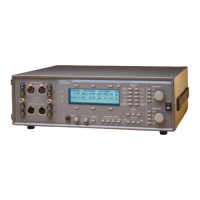calculation will not be correct. The generator’s source impedance is
included in the calculation, so if you change the source impedance of
the analog generator, it will change the output voltage of the analog
generator.
Part of the analog generator’s source impedance is shared between
the two channels, so this must be included in the dBm calculations.
Any channels that are turned on for generation are assumed to be
loaded with the specified impedance. For proper amplitude
calibration, make sure that any generator channels which are turned
on are also loaded.
The impedance reference used in dBm calculations can be selected on
the Analyzer Only panel when dBm units are selected.
Digital Status Bits
The digital carrier signal (AES/EBU or SPDIF-EIAJ) contains not only
the embedded audio signal, but a number of status bits. Control of
these bits is provided by the Status Bits panel. To reach this panel,
press the ATS-1 PANELS button until you see this display:
The center part of this panel, enclosed in the rectangle, shows the
incoming status bits. The part of the panel outside the rectangle
allows control of the sent status bits. Control is provided by the soft
keys.
The upper left soft key controls the Consumer/Professional mode bit.
Pressing this soft key will toggle between the two modes. Since the
status bits are allocated differently for the two modes, this changes the
other available selections. The AES/EBU standard (usually balanced)
defines Professional mode, although Consumer mode is sometimes
used. The SPDIF-EIAJ standard (usually unbalanced) defines
Consumer mode.
Figure 3-12. Status Bits Panel
& For instructions
on navigating to a
specific panel, see
page 3-3.
& For more
information on status
bits, see page 4-48.
3 Operation
Controlling the Generators Operational Overview
3-20 ATS-1 Dual Domain User's Manual

